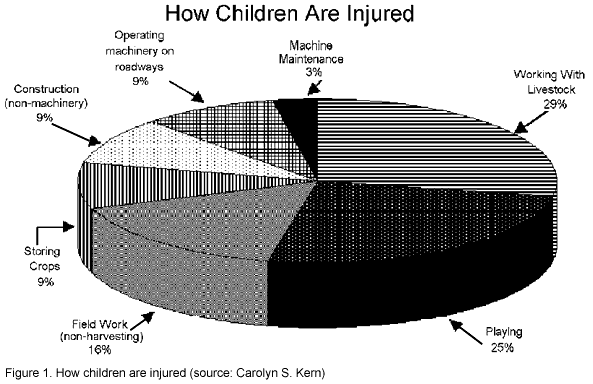Fact: Injuries are the leading cause of childhood death in the United States.
Fact: Farm machinery causes 85 percent of all machinery-related deaths to children.
Fact: The main sources of childhood farm-related injuries and deaths can be prevented.
Fact: Nearly all childhood farm-related injuries and deaths can be prevented.
The farm is a dangerous place for children because they live where work is performed. It is difficult for children to separate their play from farm hazards. To a child, a grain bin is a fascinating and adventurous place. However, many of these adventures have tragic endings.
Children on their own cannot recognize farm hazards. They must be taught how to recognize farm dangers and how to avoid them. The following are dangers that should be discussed with children:
The chart in Figure 1 shows how children are injured on a farm. For additional information on the above topics, contact your county office of Ohio State University's Cooperative Extension Service.

Young children learn primarily by touch and sight. Many times these two senses put a child into a dangerous situation. For example, fascination with a quickly moving PTO can result in disaster. However, these senses can also be used to teach children about farm hazards. For example, bright safety emblems can be used as flash cards to teach children farm hazards. Models of farm equipment can also be used to demonstrate and prevent possible accidents.
(For further child development information see fact sheet AEX 991.1, What Job is Right for my Child?)
Parents and grandparents should use precautionary safety measures to prevent accidents. They can set and enforce safe limits and be good role models for children by promoting farm safety.
The following are key steps to farm safety:
Farm-related injuries occur while children are both at play and at work. The majority of children over the age of seven are participating in farm labor when injured. Children perform a lot of duties on farms and are a valuable resource, but children working on farms have a high rate of injury. Proper safety training can minimize the risk of injury to your child.
HOW TO GET EMERGENCY MEDICAL HELP
SOURCES
Publication #: AEX-991
This document is a series of the Agricultural Engineering Department and Department of Preventive Medicine, Ohio State University Extension, Columbus, Ohio 43210. Supported in part by project #MCH394001-02-1 from the Emergency Medical Services for Children program, Health Resources and Service Administration Department of Health and Human Services. Publication date: October 1992.
Thomas L. Bean, Safety Leader; Jennifer Wojtowicz, Graduate Assistant, Ohio State University Extension, Columbus, Ohio 43210. Reviewed by Dr. Randall Wood, Dr. Sue Nokes and Mr. Ron Clason, Agricultural Engineering Department.
Disclaimer and Reproduction Information: Information in NASD does not represent NIOSH policy. Information included in NASD appears by permission of the author and/or copyright holder. More